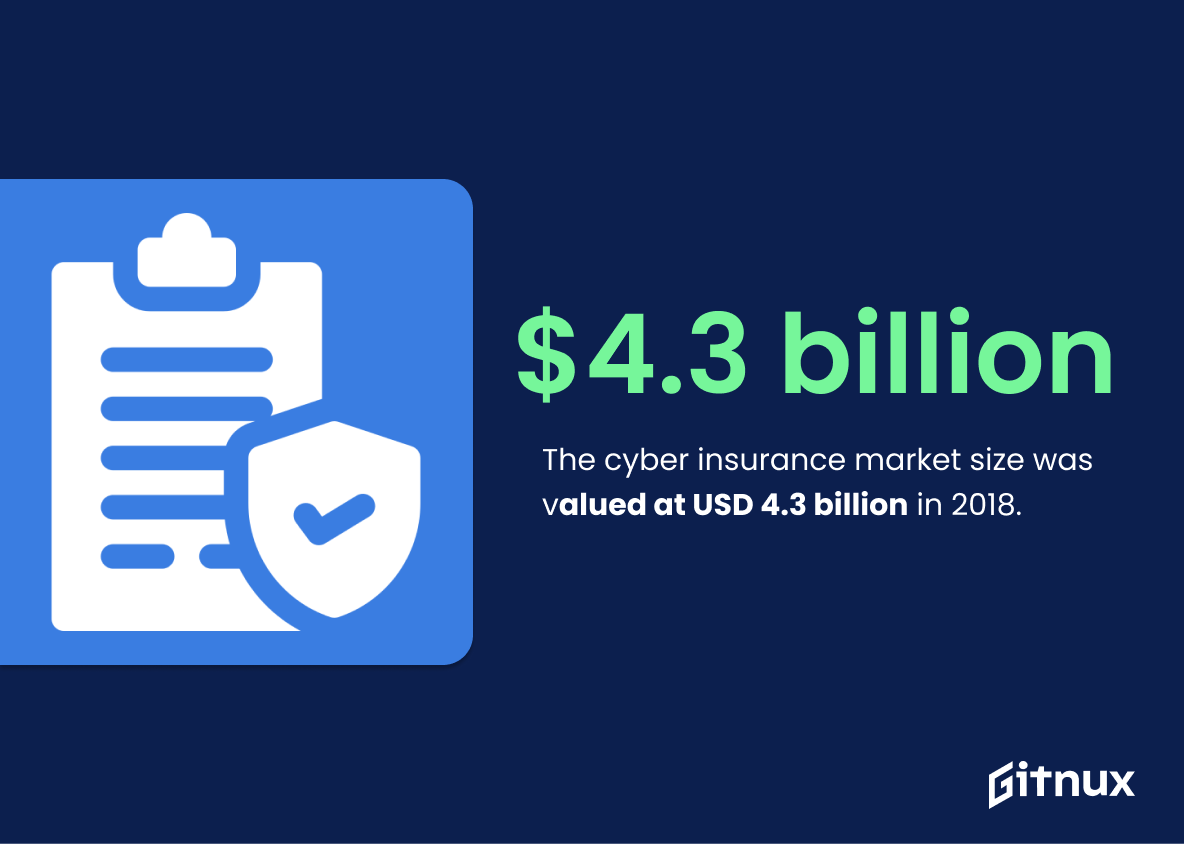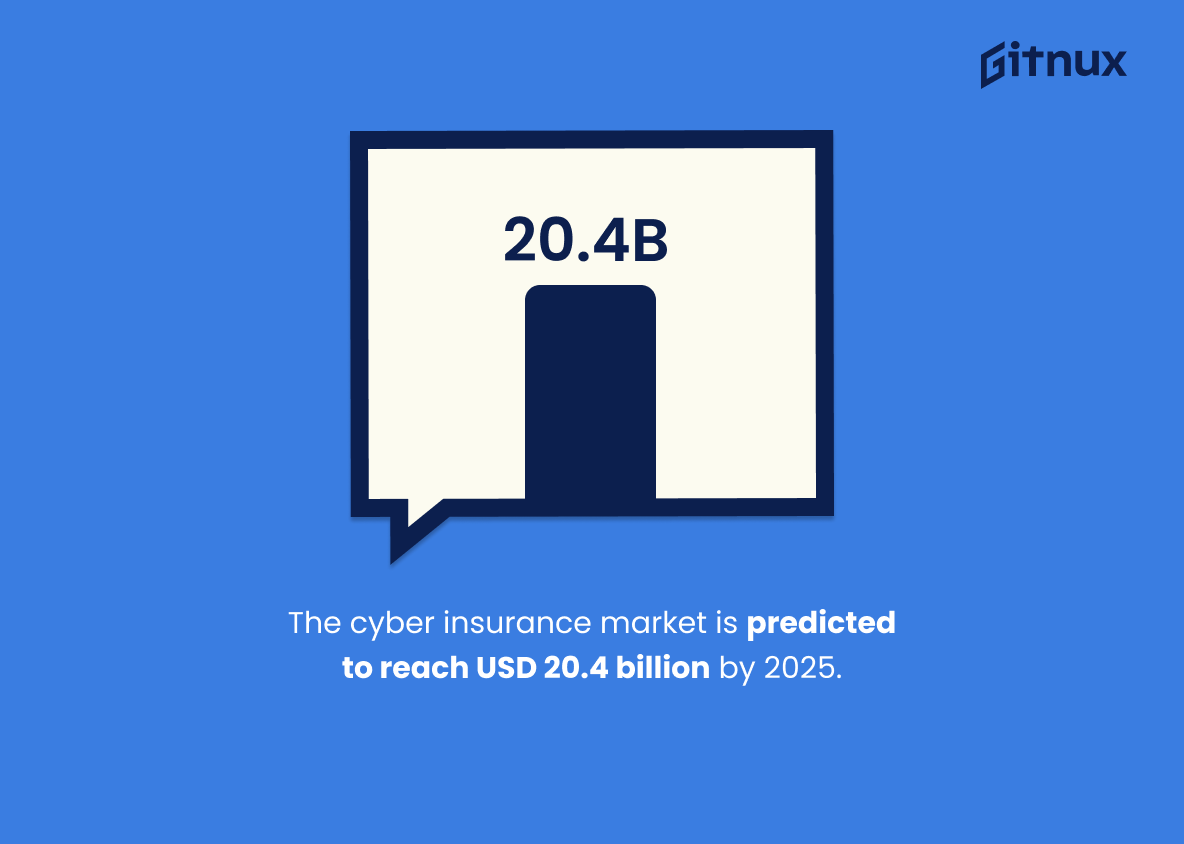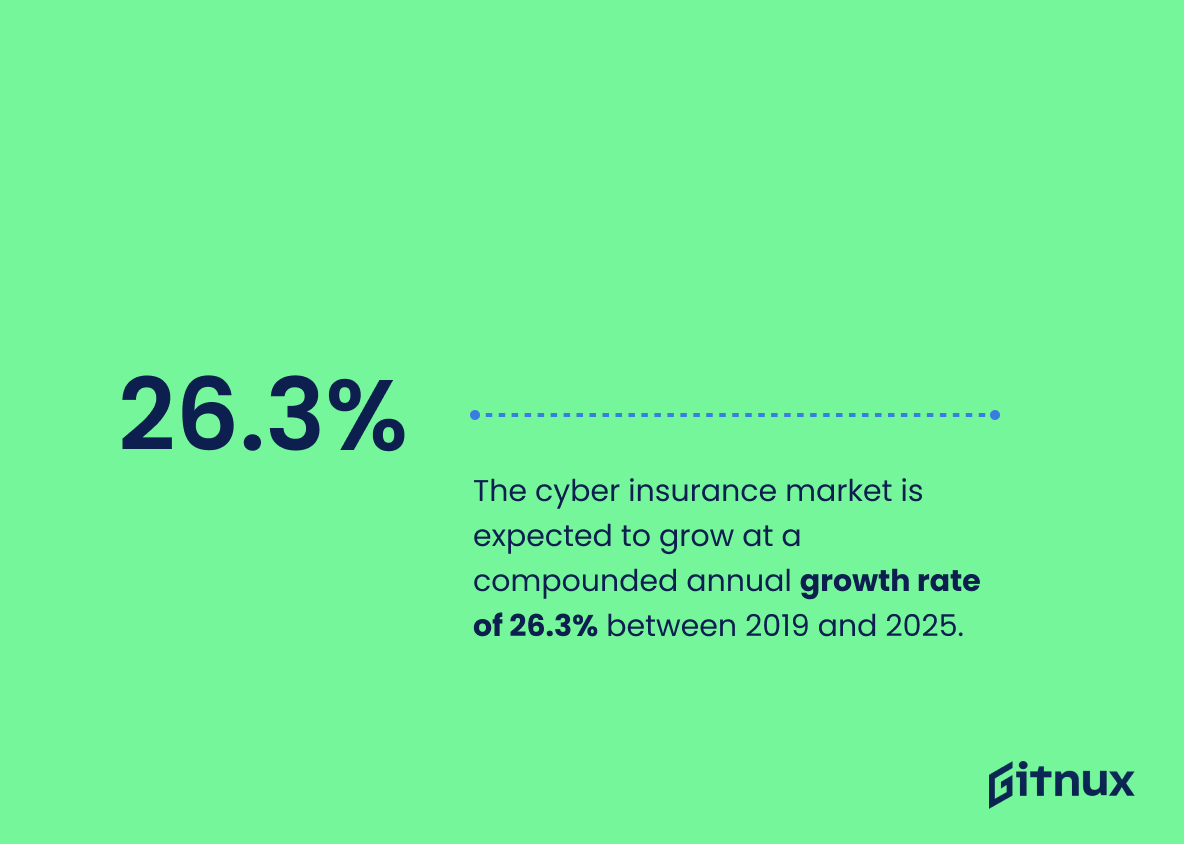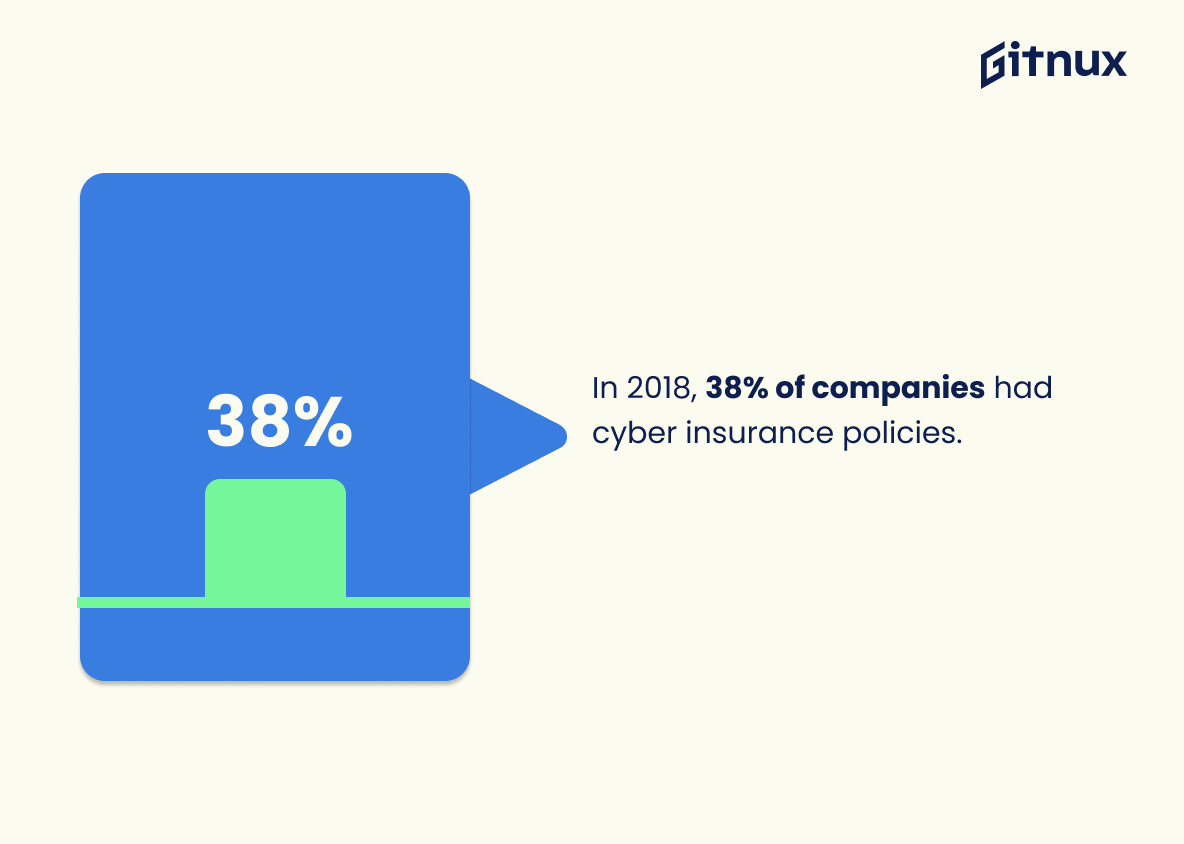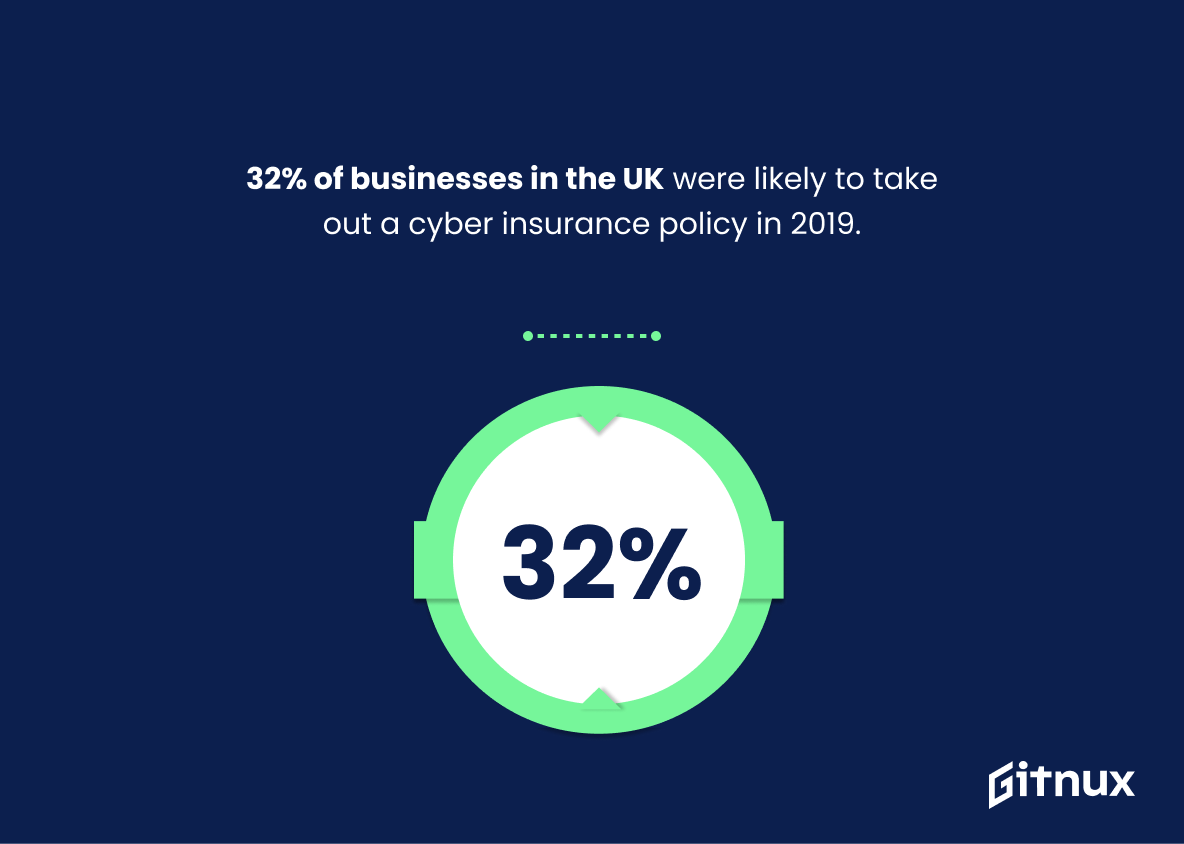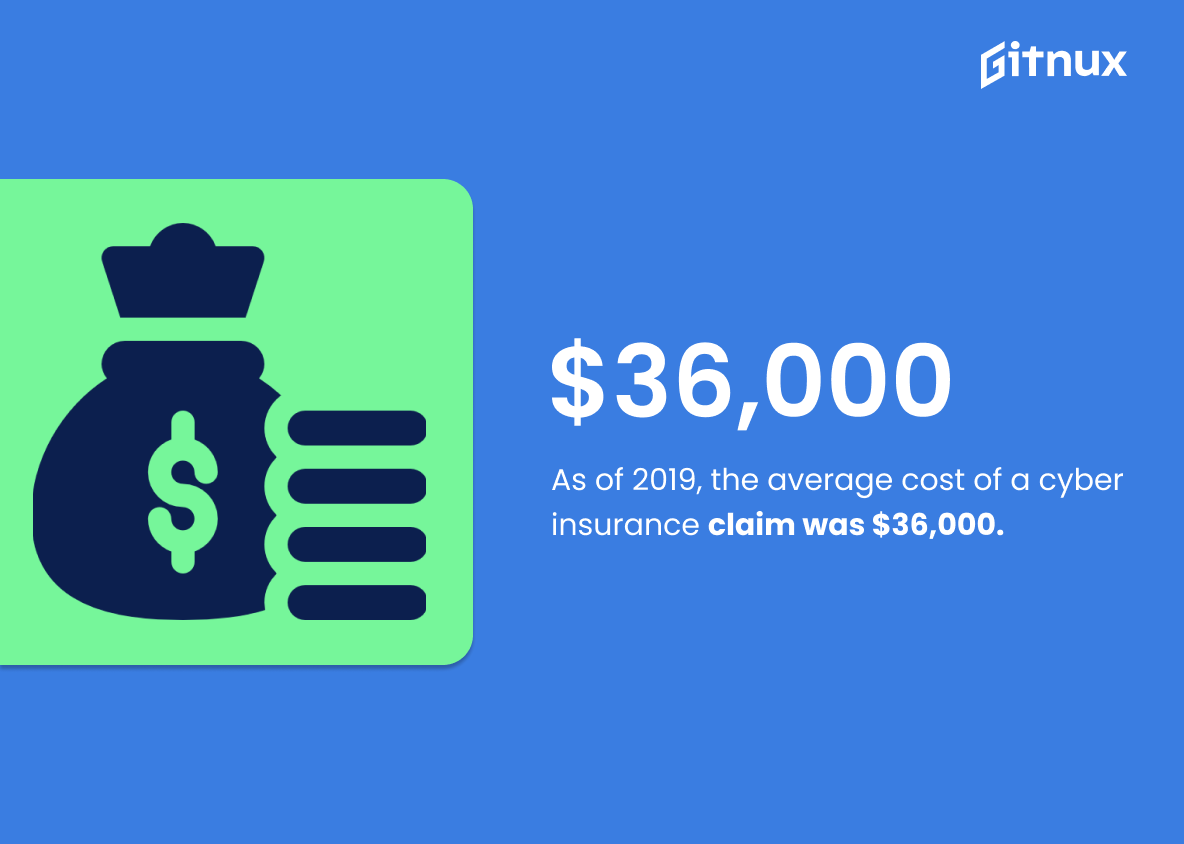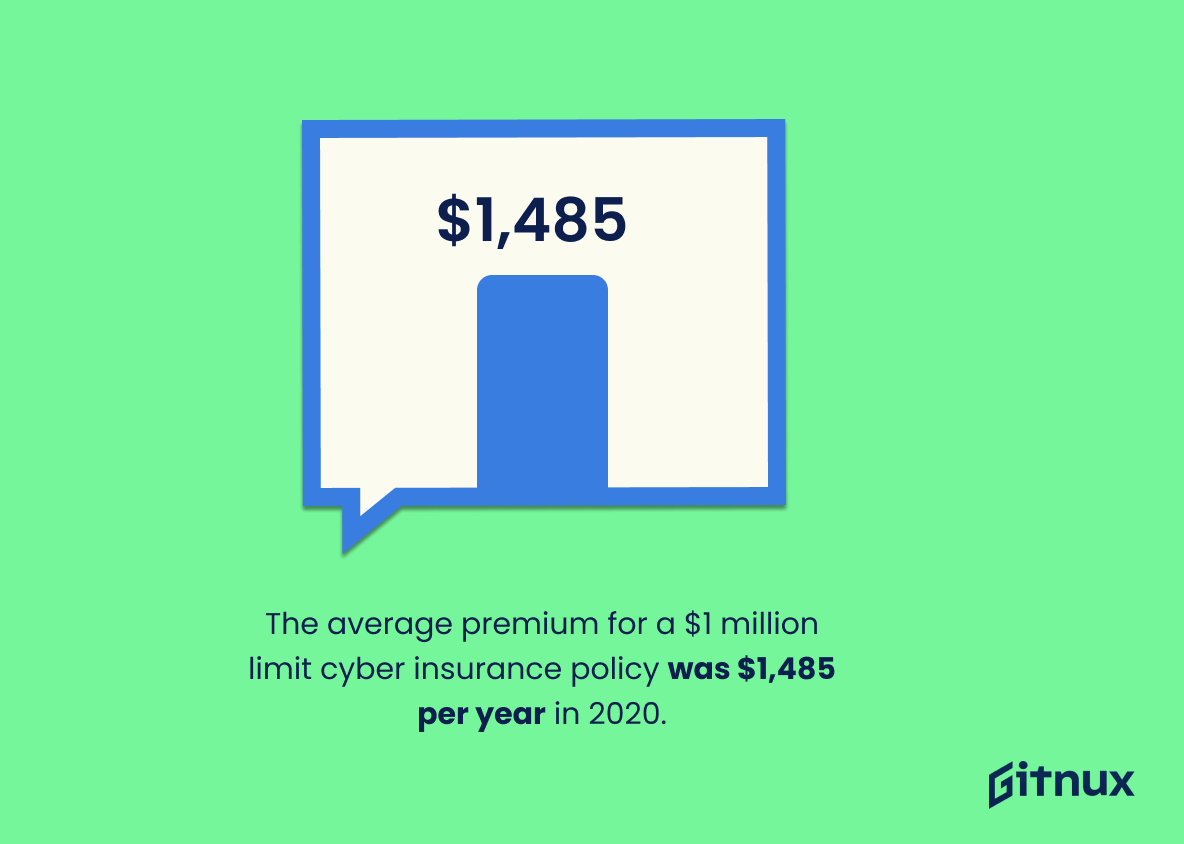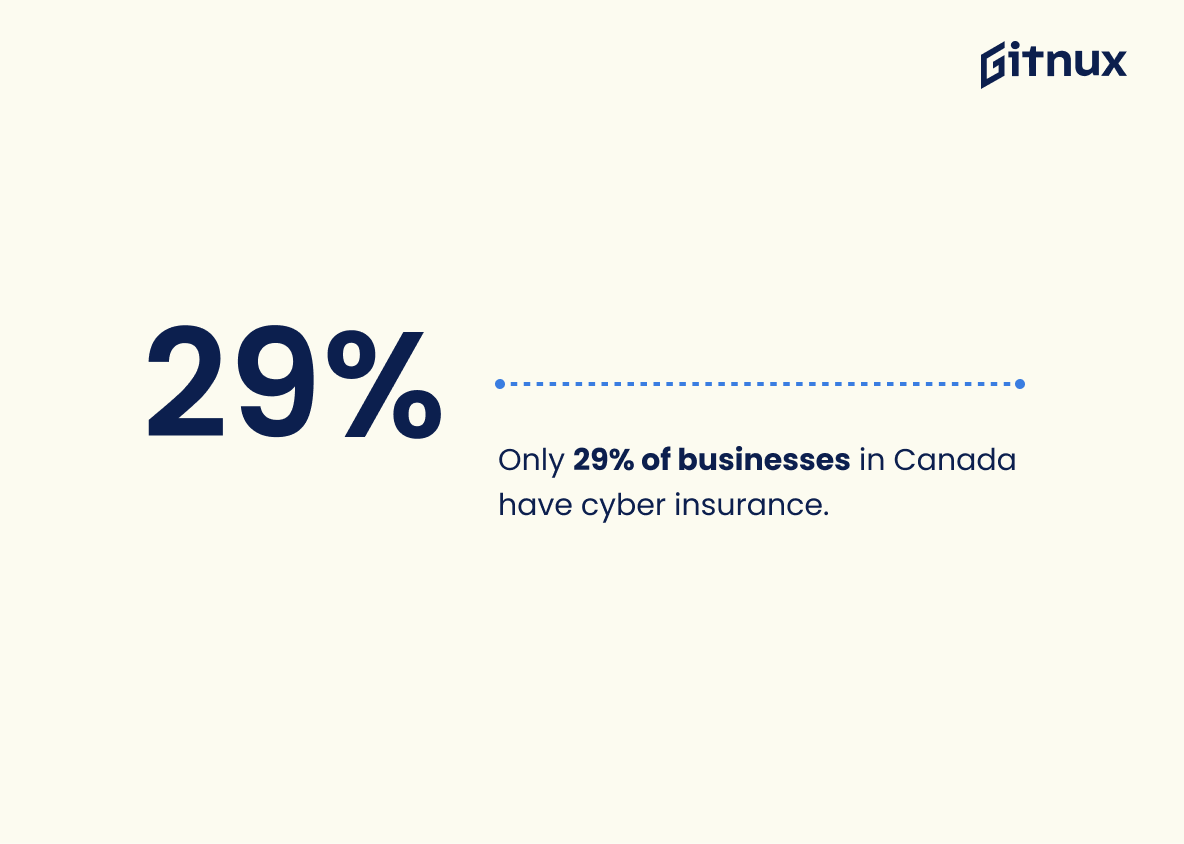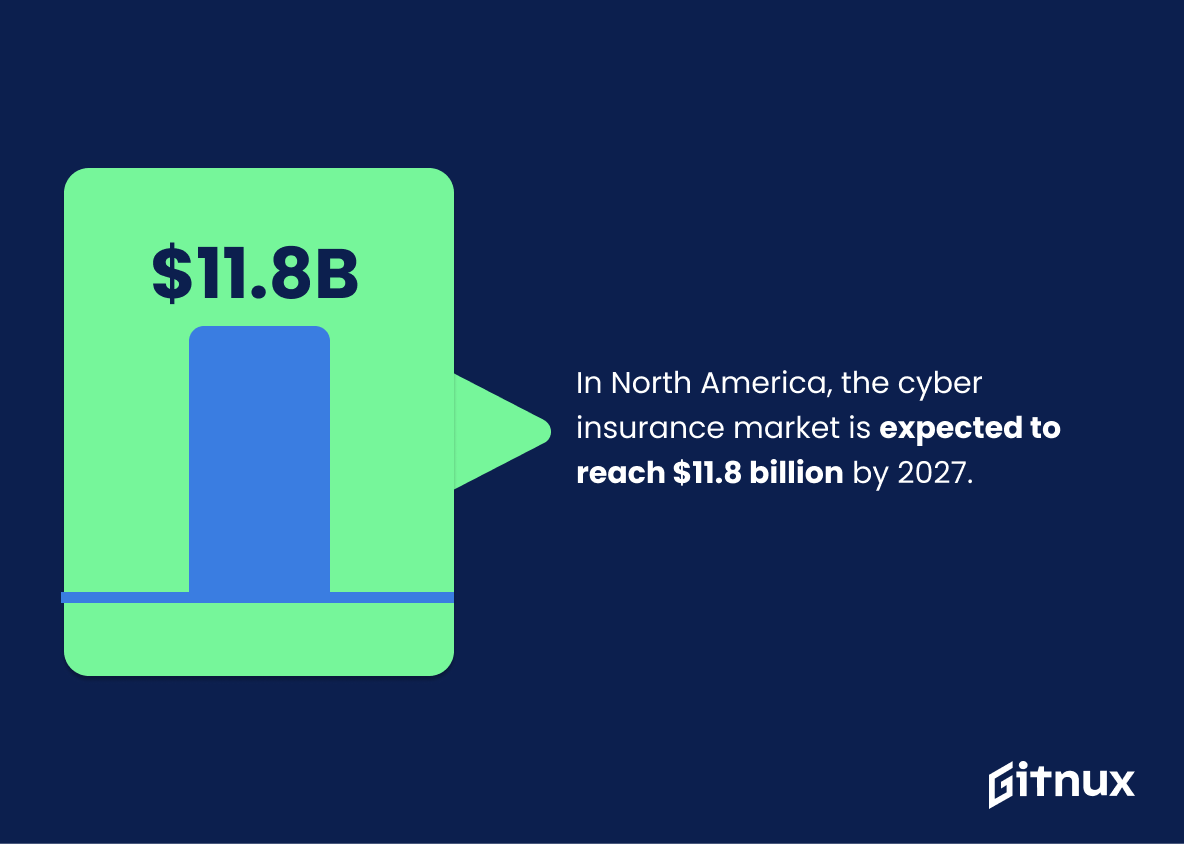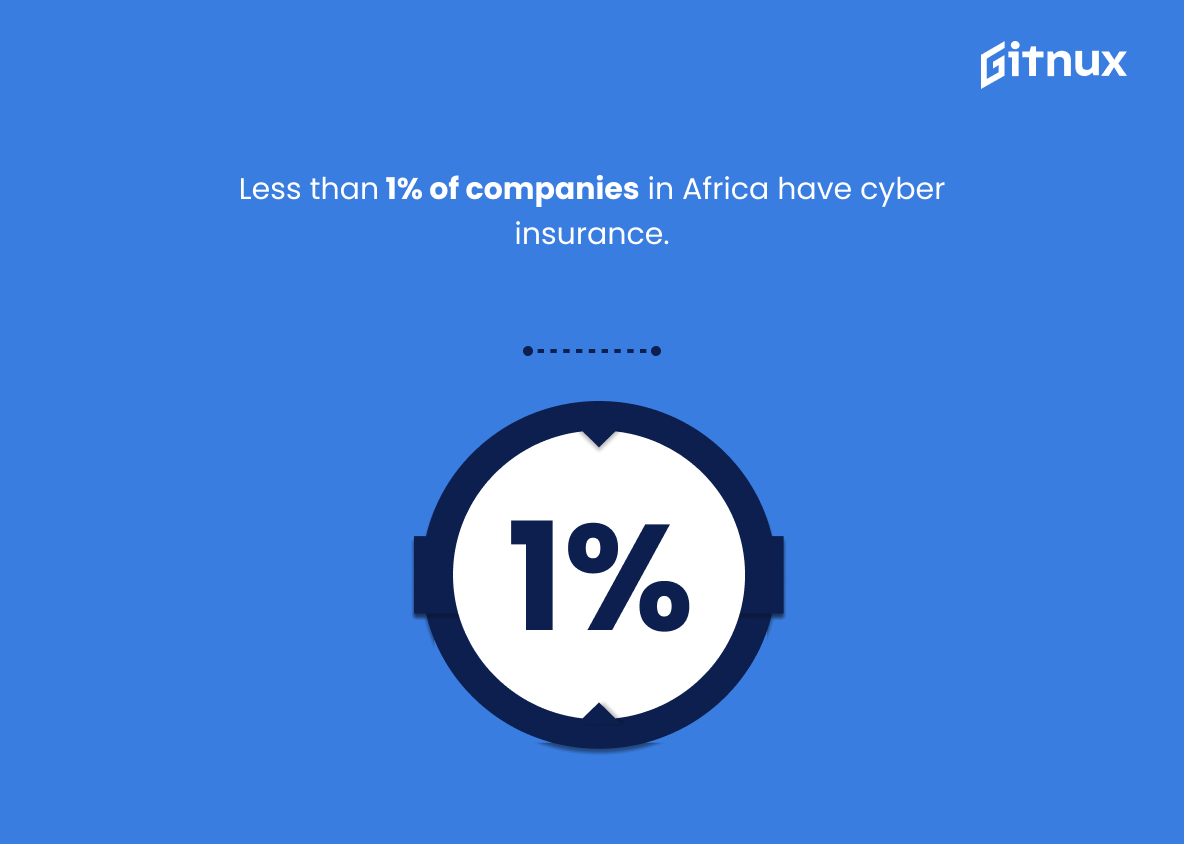In today’s highly interconnected digital world, the rise of cyber threats is not a possibility, but a reality. These threats not only pose risks to personal data, but also to the financial robustness of businesses large and small. To combat these digital perils, the value of cyber insurance has skyrocketed in unprecedented measures. Our blog post delves into deep discussions on the critical cyber insurance statistics that illuminate the broadening scope and escalating importance of this modern security blanket.
This insightful data will shed light on the growing necessity of cyber insurance, providing you with figures that underscore its position in the ever-evolving landscape of cybersecurity. Stay with us as we break down the numbers behind the risks, costs, and preventative measures involved in securing today’s hyper-virtual business realities.
The Latest Cyber Insurance Statistics Unveiled
The cyber insurance market size was valued at USD 4.3 billion in 2018.
This mesmerizing figure of USD 4.3 billion, emerging from the evaluation of the cyber insurance market size in 2018, paints an intriguing picture of the critical role that such insurance plays in our increasingly connected world. Woven into a blog post about Cyber Insurance Statistics, it anchors the narrative by presenting indisputable evidence of the noteworthy financial implications of cyber risks and the importance individuals and organizations place on safeguarding against them.
This monetary marker serves as a testament to the burgeoning reliance on cybersecurity measures, and lends a certain gravitas to discourse around digital safeguards. This financial footprint, in essence, helps shape an understanding of how the global community is rising to the challenge of dealing with cyber threats, making it a vitally important part of the cyber insurance statistics story.
The cyber insurance market is predicted to reach USD 20.4 billion by 2025.
Diving headfirst into the fascinating world of cyber insurance statistics, it’s incredibly intriguing to envisage a future where the cyber insurance market skyrockets to USD 20.4 billion by 2025. This paramount projection doesn’t merely represent financial growth, but also underscores the escalating significance of cyber insurance in our digitally dominant era.
It is a clarion call to organizations and individuals alike, beckoning them to proactively safeguard their cyberspace from potential threats and risks. This vivid depiction of the future accentuates the urgency and necessity of investing in cyber insurance today, for the digital world we navigate tomorrow.
The cyber insurance market is expected to grow at a compounded annual growth rate of 26.3% between 2019 and 2025.
Delving into the fascinating world of Cyber Insurance Statistics, one cannot overlook the projected boom in the cyber insurance market, with an anticipated compounded annual growth rate of 26.3% between 2019 and 2025. This astronomical growth rate is not just a number, it’s a prophecy of the swelling need for digital protection.
For any business or individual navigating the complex currents of the cyberspace, this momentum underlines the liability inherent in our digital age and the escalating importance of securing the right cyber insurance. As the marketplace surges forward, it’s an undeniable reminder to stay informed, proactive and ensure digital risk management remains a top priority.
In 2018, 38% of companies had cyber insurance policies.
Unveiling the digital veneer of the year 2018, it’s intriguing to note that only 38% of companies guarded their technological fortresses with cyber insurance policies. These numbers serve as a poignant reminder of the emerging importance and uptake of protective measures in a progressively vulnerable digital landscape.
In a discussion on cyber insurance statistics, such a figure provides both an intriguing insight – into the perceived value of cyber insurance at that time – and a compelling benchmark – against which future progress can be measured. It paints a picture of the corporate cyberspace wherein the majority of the businesses navigated the menacing labyrinth of cyber threats without a safety net, thereby accelerating the urgency for turning the tide in favor of increased cyber insurance coverage.
32% of businesses in the UK were likely to take out a cyber insurance policy in 2019.
The vibrant click of 32% pops out, undeniably striking on-screen, echoing the percussive note of UK businesses ready to step into 2019 armored with a cyber insurance policy. The fragrance of readiness strikes the air, a scent picked up by the statistics-savvy, spelling out a compelling narrative that highlights the growing awareness and proactiveness amongst UK businesses. As a chandelier reigns majestically in a royal banquet, this statistic commands attention in a blog post about Cyber Insurance Statistics.
Not as an isolated number, but a critical player painting a stunning tableau of companies’ evolving strategies in dealing with potential cyber threats. A vigil against darkness, if you will, suggesting change is no more optional but obligatory, a response to the throaty growl of rising cyber threats.
As of 2019, the average cost of a cyber insurance claim was $36,000.
In the cyber insurance landscape, the noteworthy average claim figure of $36,000 in 2019 punctuates a fundamental reality. It helps highlight the stark fiscal implications cyber threats hold for businesses. This substantial figure underscores the crucial need for companies to invest in robust cyber insurance policies.
Contextualized further, it unravels that cyber threats are not just dangerous – they are financially ruinous, indicating the literal price of vulnerability in our modern digital environment. So, if you’re navigating the cyber insurance waters, remember that $36,000 is not just an average claim cost — it’s a wakeup call.
The average premium for a $1 million limit cyber insurance policy was $1,485 per year in 2020.
Highlighting this specific figure illuminates the comparative affordability of cyber insurance, particularly in the face of potential million-dollar losses that can result from cybercrime. For businesses, this serves as a tangible, numerical beacon, guiding them towards the prudent decision of investing in cyber insurance. It’s not just a figure, but a compelling argument: for just a small fraction of your potential loss, you can secure a safety net. This statistic underscores one of the pivotal digits in understanding the value proposition of cyber insurance in this increasingly digital age.
Only 29% of businesses in Canada have cyber insurance.
Diving into the digital depths of cyber insurance, the fact that a mere 29% of Canadian businesses are equipped with cyber insurance is a striking revelation. This nugget of data offers a stark reflection of the cybersecurity landscape, signifying either a perceived lesser threat level or a risky neglect about cyber defense among a notable 71% of Canadian businesses.
This has profound implications in a world where phishing e-mails, ransomware attacks, and data breaches are becoming almost run-of-the-mill scenarios. Therefore, it lays bare the urgent need for enhanced advocacy, awareness, and comprehensive coverage in the cyber insurance domain, making this statistic an integral part of the conversation on cyber insurance trends and necessities.
In North America, the cyber insurance market is expected to reach $11.8 billion by 2027.
Delving into the crystal ball of Cyber Insurance, a prediction as substantial as an $11.8 billion market valuation for North America by 2027 underscores the profound transformation this field is poised to undergo. This projection intertwines the financial trajectory of the market with the gripping narrative of cybersecurity’s steady crawl from the shadows into the glaring spotlight.
Trapped in an era of digital revolution, this statistic evokes a vivid image of soaring demand for cyber insurance fuelled by the escalation of cyber threats. Hence, in the grand narrative of Cyber Insurance Statistics, this statistic is akin to a powerhouse protagonist, imparting a forecasting tale of growth, amplified relevance, and potential profitability.
Less than 1% of companies in Africa have cyber insurance.
Delving into the enigmatic realm of cyber insurance statistics, we often underestimate the glaring reality of these numbers. To illustrate, we focus on an eye-opening fact: less than 1% of companies in Africa are covered by cyber insurance. An alarmingly low figure that reflects both a lack of understanding and a worrisome underpreparedness in the face of the burgeoning cyber threat landscape.
On the digital battlefield, this minuscule percentage scrolls across the panorama like a ticking time bomb. It implicates a multitude of African enterprises in a high-stakes game of risk, spotlighting a vast unprotected territory where the reach of cybercrime may yet remain unimpeded. The statistic singlehandedly conveys the urgency for a greater emphasis on cyber education and insurance adoption across the African continent, stressing their pivotal role in building a fortified business environment resilient to cyber threats.
In 2020, 25% of small businesses had a cyber insurance policy.
Delving into the essence of the 2020 statistics, a noticeable 25% of small businesses were armored with a cyber insurance policy. This figure is significant in our conversation on Cyber Insurance Statistics, because it provides a barometer to comprehend the depth of cyber insurance uptake among small businesses.
By using this statistic as a launchpad, it adroitly shows the degree of risk awareness that was present amidst a quarter of these ventures. It directly reflects upon the business owner’s cognizance of the cyber threats that they could potentially face. By carrying this insurance policy, these businesses are signifying an understanding of today’s digital landscape and the inevitable risks lurking.
Furthermore, seeing that this statistic pertains to a recently concluded year, it affords us valuable insights into contemporary security approaches adopted by small businesses, thereby enabling us to measure shifts and growth within this sector. It serves as a comparative reference enabling us to assess how far businesses have come in their cybersecurity strategies over recent years and where they might be heading.
Casting light on such a crucial avenue, this statistic commands center stage in any informed dialog on Cyber Insurance Statistics.
As of 2021, the average cost of cybercrime in the United States was $27 million.
Painting a harrowing digital landscape, the staggering average cost of cybercrime in the United States—an astounding $27 million in 2021—brings to light the urgent necessity of robust safeguards. When weaving this background into a discourse on cyber insurance, this figure serves as a startling revelation of potential financial ruin that businesses could face due to the menace of cybercrime.
In the realm of insurance, each risk calculation, each premium set, is dictated by the underlying costs and probability of that adverse event happening. This $27 million figure highlights not just the prevalence of cybercrime, but also the depth of its financial consequences—providing a compelling justification for the rise of cyber insurance. It reaffirms the need for businesses to invest in cyber insurance as a shield against financial devastation, underscoring the blog post’s importance and the gravity of the topic at hand.
The health sector is at highest risk of cyber threats, accounting for 79% of all reported cyber incidents in 2020.
Imagine walking through a city where, astonishingly, 79% of all robberies happened in just one neighborhood. You’d certainly want extra protection if you lived there, right? That’s essentially the situation we’re seeing in the digital city. The health sector represents that singular neighborhood, accounting for an overwhelming 79% of all reported cyber incidents in 2020. From ransomware attacks on hospitals to breaches of confidential patient data, the health sector is facing an onslaught of cyber threats.
The sheer volume of attacks in this sector underscores the pivotal role that cyber insurance can play. Certainly, it emphasizes the necessity for organizations in the health sector to avail cyber coverage as a key part of their risk management toolkit. Businesses in the health sector must keep themselves updated about the latest cyber insurance statistics and use this knowledge to shape comprehensive, effective insurance strategies. Cyber coverage can help cushion the financial impact in the event of a security breach and enable quick recovery – a cyber safety net, if you will, for health sector actors playing in a high-risk game.
In 2017, the Asia Pacific cyber insurance market stood at around $133 million.
Highlighting the figure of the Asia Pacific cyber insurance market in 2017 at around $133 million significantly underlines the growing awareness and the rising demand for cyber insurance in this region. This substantial figure serves as a testament to the reality of the pervasive cyber threats that businesses face in the digital era.
With this information at hand, readers can clearly visualize the market size and understand the importance of preventive measures, such as cyber insurance to mitigate potential risks. Moreover, this pecuniary data can trigger fruitful reflections on potential growth and future prospects for the cyber insurance industry in the Asia Pacific region, thereby adding substantial weight to a blog post about Cyber Insurance Statistics.
Only 5% of European SMEs have a cyber insurance policy.
The striking revelation that a mere 5% of European SMEs have a cyber insurance policy sets a dramatic landscape for our conversation on Cyber Insurance Statistics. This proportion, seemingly small at first glance, actually offers a broader lens into the current perceptions, preparedness and attitudes surrounding cyber insurance amongst the SMEs in Europe.
With an overwhelming majority of 95% navigating their online undertakings uninsured and exposed to cyber threats, this figure sharply highlights not just an area of concern but also a sector ripe with potential for cyber insurance growth. This alarmingly low percentage serves as a clarion call for SMEs: the cyber world is fraught with risks and it’s high time to armor up.
As of 2021, ransomware attacks cost businesses over $20 billion.
This eye-opening statistic underscores the significant toll that ransomware attacks takes on businesses, a whopping $20 billion as of 2021. Highlighting this massive figure adds fuel to the imperative discourse on cyber insurance in the modern business landscape.
When considering these staggering financial implications, it becomes dramatically clear how vital it is for businesses to shield themselves against possible financial devastations resulting from cyber threats with a robust cyber insurance policy. Hence, this beyond-belief figure serves as a clarion call for businesses worldwide, prompting them to reassess their risk management strategies and prioritize cyber insurance.
The underwriting capacity for standalone cyber policies can range from $5 million to $100 million, depending upon the risk and the insurer.
Highlighting the varying underwriting capacity for standalone cyber policies offers vital juice to our discussion about Cyber Insurance Statistics. This figure, ranging between $5 million to $100 million, provides an illuminating glimpse into the financial implications and the magnitude of risk involved in the cyber insurance market. It underscores the importance of adequate coverage in an era fraught with digital threats and vulnerabilities.
Furthermore, these numbers signal the diverse appetites of different insurers in underwriting cyber risks. So, whether you’re a small-scale business seeking a safety net or a conglomerate in need of substantial coverage, this statistic serves as your compass navigating the vast landscape of cyber insurance.
92% of UK businesses purchasing cyber insurance retain the first $10,000 in losses.
Drawing a spotlight onto the intriguing revelation, we uncover a striking trend where a substantial majority, 92% to be exact, of UK businesses that invest in cyber insurance opt to shoulder the initial $10,000 in losses. What this tells us is that businesses are cognizant of the increasing risks in the digital world and are strategically positioning themselves to absorb a certain level of these risks. This strategy not only helps in reducing premium costs but also underscores the magnitude of ownership businesses are willing to accept in the face of potential cyber threats.
Such a trend also signifies a notable shift towards self-reliance, raising thought-provoking questions on measures that these businesses are likely taking to buttress their defences, beyond mere insurance coverage. This statistic without a doubt, offers a fascinating insight into the risk management strategies adopted by businesses in the increasingly complex realm of cyber security.
Approximately 26% of U.S. companies have adopted cyber risk insurance by 2016.
Highlighting the fact that nearly a quarter of U.S. companies had cyber risk insurance as of 2016 underscores the growing recognition of digital threats within the business world. It’s an alarm bell, reminding us that with continuous miracles of technology, there’s a shadow side to the digital era – one that’s potentially hazardous. This figure of 26% serves as a waterline, pointing to a rising tide of businesses that are no longer willing to gamble on the safekeeping of their virtual realms.
Cyber insurance, once considered a luxury, now begins appearing as a line item in budgets. In the bigger picture, this shift points to our evolving digital culture where cyber security moves from the periphery to the core of business strategies.
As of 2019, the average cyber claim for large companies stands at $3.9 million.
Diving into the real-world significance of this statistic, let’s regard the $3.9 million figure as a vivid portrayal of the escalating costs of cyber threats for large companies. This figure not only underscores a worrisome financial exposure risk in the current digital landscape but also emphasises the need for robust cyber insurance.
Within the narrative of our Cyber Insurance Statistics blog, this statistic acts as a wake-up call, urging companies to better understand their potential vulnerabilities, grapple with the reality of cyber threats, and reconsider the value and reassurance that comprehensive cyber insurance coverage can offer.
Conclusion
The evolving digital landscape has undeniably made cyber insurance a pivotal aspect of any business strategy. The numbers in our cyber insurance statistics underscore the rising significance of this protection in the face of increased cyber threats. These trends highlight the importance of staying informed and taking proactive measures to mitigate risks that could cripple businesses.
The statistics and facts we have shared solidify that investing in a powerful cyber insurance policy is no longer just an option but a necessity in the modern business world. In a nutshell, there is no better defense against digital threats than being prepared.
References
0. – https://www.www.insurancebusinessmag.com
1. – https://www.www.helpnetsecurity.com
2. – https://www.cybersecurityventures.com
3. – https://www.www.businesswire.com
4. – https://www.www.statista.com
5. – https://www.www.aon.com
6. – https://www.www.gminsights.com
7. – https://www.www.grandviewresearch.com
8. – https://www.www.ponemon.org
9. – https://www.www.canadianunderwriter.ca
10. – https://www.www.iii.org
11. – https://www.www.businessinsurance.com
12. – https://www.www.businessdailyafrica.com
13. – https://www.advisorsmith.com
